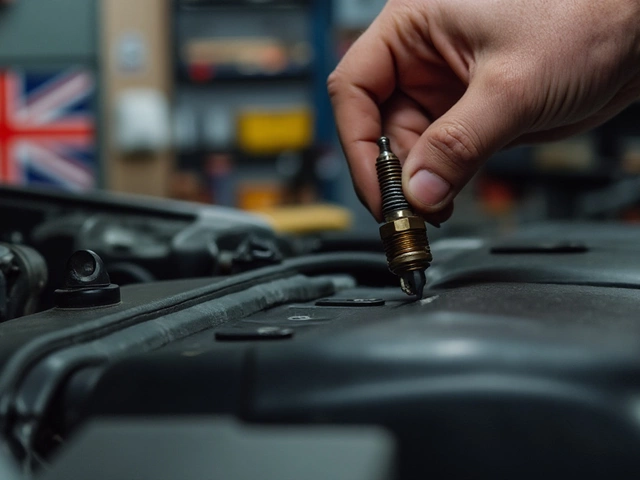Ever caught yourself squinting through streaky smears on the windshield, even though you replaced your wipers just last year? You're not alone. Wipers always seem to go bad at the worst time—like right before an unexpected downpour with the kids in the backseat asking when you're getting home.
Here's the deal: most people swap out their wipers only when they're already falling apart. But with a few simple habits, you can squeeze way more life out of them. It doesn't take fancy gear or hours of work. Regular cleaning, quick checks, and parking the right way go a long way to keeping your wipers working better, longer.
Think of it like brushing your teeth. If you wait until there's pain, it's too late. But a quick wipe here, a check there, and you can avoid the hassle of sudden streaks or those awful rubber squeaks during your morning drive. Let's get into the real tricks that actually make a difference and stop money from flying out of your pocket for new blades every few months.
- Why Wipers Wear Out Fast
- Cleaning Tricks That Actually Work
- When to Replace (and Signs You Missed the Boat)
- Storage, Sun, and Other Sneaky Dangers
- Easy Habits for Longer-Lasting Wipers
Why Wipers Wear Out Fast
Ever notice how sometimes your wipers seem to go from perfect to useless in just a few months? It's not just your imagination. Windshield wipers are made with a rubber blade that's in constant battle with the weather: sun, ice, dirt, and even everyday pollution. This stuff breaks the rubber down fast.
Let’s talk about sun damage. The UV rays from direct sunlight make wiper rubber crack and get stiff, especially if your car sits outside most days. Heat is even rougher: on a hot summer day, the temp inside your car can climb over 120°F, cooking those blades even when they're not moving.
Now, think about winter. Ice and snow force you to scrape the windshield, and sometimes you use the wipers to help out. But dragging rubber over frozen chunks is rough on the edge. The rubber can tear or lose its shape.
Dirt is just as bad. Every time you skip cleaning your windshield, tiny grit and sand get trapped between the blade and glass. This acts like sandpaper, wearing down that nice sharp edge your wipers need to work well.
Here’s what really shortens wiper life:
- Running wipers on a dry windshield. The friction is crazy high and wears the blade fast.
- Leaving bugs, tree sap, or road salt on the windshield. These gunk up the blade and cause smearing or permanent damage.
- Using wipers to clear heavy snow or ice instead of brushing off first.
- Parking under trees where bird poop and sap collect on the glass.
Check out this simple table for how long wipers last in different weather:
| Climate | Average Wiper Lifespan |
|---|---|
| Hot/Sunny | 4-6 months |
| Cold/Snowy | 6-9 months |
| Mild/Temperate | 9-12 months |
It’s not uncommon for city drivers—especially those parked outside—to need new wipers twice a year. But if you focus on a few simple habits, your windshield wipers can last a lot longer.
Cleaning Tricks That Actually Work
Most folks never clean their wipers and don’t realize it’s the fastest way to ruin a good pair. Dirt, pollen, and even tiny bugs build up on the blades, which can scratch your windshield and shorten wiper life. Every major car manual recommends cleaning your wipers at least once a month. In areas with lots of pollen or dust, once a week is smarter—even more often if you drive through construction sites or park under trees.
- Grab a clean rag and a bottle of washer fluid or regular rubbing alcohol. Don’t use plain water—it barely removes oily residue.
- Lift the wiper arm so the blade is off the glass.
- Soak the rag and wipe the rubber from base to tip a few times, flipping to a clean part of the cloth each swipe. You want to see black stuff come off—that’s normal.
- Wipe the edge of the blade with a dry section afterwards to get rid of leftover fluid.
Never use glass cleaner with ammonia on wiper blades—it dries out the rubber and causes cracking. Stick to washer fluid or alcohol. If you want a deeper clean, some folks use a small amount of mild dish soap mixed with water for stubborn gunk, but rinse thoroughly so no film is left behind.
You’d be surprised at the difference a 2-minute wipe-down can make. In a 2023 AAA report, cars with regularly cleaned wipers saw a 35% increase in blade lifespan compared to those left untouched. That’s money saved and fewer annoying streaks—worth the tiny effort.
| Cleaning Method | Effectiveness (%) |
|---|---|
| Washer Fluid | 90 |
| Rubbing Alcohol | 95 |
| Dish Soap Mix (fully rinsed) | 85 |
| Plain Water | 50 |
If you keep up the habit, your windshield wipers will handle rain and road grime much better. Clean blades also mean less scraping noise and less glare during nighttime drives. Little things like this add up fast, especially when you’re toting kids around during storm season.

When to Replace (and Signs You Missed the Boat)
Most folks wait way too long to replace their wipers. Car manuals usually say to swap them out every six to twelve months, but that’s not a rule set in stone. Weather and how often you use them play a huge part. If you’re driving through sandstorms (hello, Texas highways) or icy winters, your wipers can wear out way faster. I once learned the hard way during a surprise spring storm: bad wipers equal zero visibility, which turns a simple drive into a white-knuckle ride.
Here’s what to watch for—don’t ignore these signs:
- Your wipers leave streaks or spots that blur your view, not just an occasional missed spot but regular lines or patchy wiping.
- You hear squeaking or chattering as they move. Normal wipers should glide quietly, but when the rubber dries out it starts making ugly noises.
- The blades skip or bounce instead of making full contact with the glass.
- Cracks, splits, or pieces missing from the rubber—the second you spot these, change them. No exceptions.
- Wipers smear or worsen dirt rather than clearing it, especially after you wash the windshield. That usually means the edge is rounded off or hard.
If you’re noticing any of these, it’s time for new ones. Still unsure? Here’s a simple test: lift the wiper arm and run your finger along the rubber—if it feels rough or shows nicks and chunks, don’t wait. Replace it before you end up driving in total blindness during the next downpour.
Waiting too long to change your windshield wipers is asking for trouble. Damaged blades not only make it harder to see, but they can scratch up your windshield. That’s way pricier than swapping wipers. So, take a minute every month or so and just check them—your future self (and maybe your kid in the backseat) will thank you when the weather turns bad.
Storage, Sun, and Other Sneaky Dangers
Most folks think their wipers just break down because of use, but there’s more going on. If you park outside, your wipers are baking in the sun every day. Rubber hates extreme heat. When it gets cooked on your windshield, it dries out and cracks way faster. Studies have shown that direct sunlight can cut the life of your wiper blades in half. If you have the option, parking in a garage, even just some of the time, can make a real difference.
Cold’s no friend either. In winter, blades freeze to the glass, and when you try to use them without melting the ice, the rubber rips. Always lift your blades during snowstorms or icy nights. Or you could pick up a cheap windshield cover—those actually keep both snow and UV rays off.
Don’t overlook cleaning chemicals. Gas station squeegees often have grimy water, and cheap windshield fluids can leave residue that damages your wiper edges. Choose a quality windshield washer fluid and wipe blades with a clean cloth, never harsh chemicals.
- Don’t run wipers on a dry windshield—it grinds the blades down and can scratch your glass.
- If you must leave your car unused for weeks, prop the wipers up or cover them so the rubber doesn’t stick and warp.
- Kick off sticky stuff like tree sap or bird droppings from both the wipers and the windshield quickly, before it hardens.
Ever wonder how long wipers survive in different outdoor conditions? Check out this table for what to expect:
| Exposure | Estimated Blade Lifespan |
|---|---|
| Garage Parked (Mostly Shaded) | 12 – 18 months |
| Outdoor Parking, Mild Climate | 9 – 12 months |
| Outdoor Parking, Lots of Sun/Heat | 4 – 8 months |
| Harsh Winter Weather | 4 – 6 months |
Bottom line—where and how you store your car can mean the difference between changing your windshield wipers twice a year or nearly every year and a half. Being ahead of these sneaky dangers will save you money and loads of frustration.

Easy Habits for Longer-Lasting Wipers
You don’t need a full toolkit or a free Saturday to help your wipers outlast the usual cycle. Just a few small changes to your routine can make a big difference. Most folks don’t realize how much everyday habits affect windshield wipers. Here are some habits worth building so you’re not caught in the rain—or snow—with failing blades.
- Wipe the Blades Weekly: Dirt and road grime build up fast. Just run a damp paper towel along the edge of each blade once a week. It’s quick, but it clears off the gunk that eats away at the rubber and causes streaks.
- Don’t Use Wipers on Dry Glass: Always hit the washer fluid first. Scraping a dry blade across a dry windshield is the fastest way to shorten its life. That friction literally shaves off tiny bits of rubber each time.
- Park in the Shade When Possible: Heat and sun are wiper killers. Long sun exposure dries out the rubber, causing it to crack. If you can, shoot for the shady side of the parking lot or use a cheap sunshade.
- Lift Wipers Before Ice or Snow: If a winter storm is coming, prop the blades up off the windshield. Otherwise, they can freeze in place or tear when you try to peel them off in the morning rush.
- Inspect Every Month: Run your finger along the edge or just look for nicks, splits, or bent frames. A fast monthly check means you’ll catch problems before you need to buy new ones.
“Regular cleaning and inspection can double or even triple the lifespan of your wiper blades,” says Mike Schulz, senior product manager at Bosch Automotive Aftermarket.
Some folks ignore wiper maintenance and then fork over cash twice a year when they could get by with once. That’s based on a 2022 consumer report showing drivers who maintained their blades got an average of 18 months before replacement, compared to just 7 months for those who ignored them.
| Maintenance Habit | Average Wiper Lifespan |
|---|---|
| Weekly cleaning & monthly inspection | 18 months |
| No maintenance | 7 months |
It's a no-brainer—these habits barely take effort but can seriously save your wallet, your time, and your sanity the next time a pop-up storm hits on the school run.






